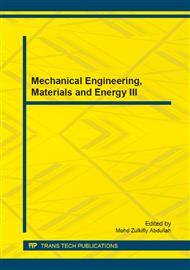[1]
Peterson W. O. (1962). Design of EHV steel tower transmission lines, Journal of Structural Division, Proceedings American Society Civil Engineers, Vol. 88, No. 1, p.39–65.
Google Scholar
[2]
Marjerrison M. (1968). Electric transmission tower design, Journal of Structural Division, Proceedings American Society Civil Engineers, Vol. 94, No. 1, p.1–23.
Google Scholar
[3]
Williams, D.C.J. and Brightwell, I.W. (1987).
Google Scholar
[4]
Delvecchio J.N. and Soom, A. (1991). Tolerances and available relative motion in bolted connections, Advances in Design Automation, ASME, Vol. 2, No. 4, p.177–183.
DOI: 10.1115/detc1991-0117
Google Scholar
[5]
Knight GMS and Santhakumar AR. (1993). Joint effects on behavior of transmission towers, Journal of Structural Division, ASCE, Vol. 119, No. 3, p.689–712.
Google Scholar
[6]
Chan SL and Cho SH. (2008). Second-order analysis and design of angle trusses part I: elastic analysis and design, Engineering Structure, Vol. 30, No. 3, p.616–25.
DOI: 10.1016/j.engstruct.2007.05.010
Google Scholar
[7]
Chan SL, Cho SH. (2008). Second-order analysis and design of angle trusses part II: plastic analysis and design, Engineering Structure, Vol. 30, No. 3, p.626–31.
DOI: 10.1016/j.engstruct.2007.04.022
Google Scholar
[8]
Fong M, Cho SH and Chan SL. (2009). Design of angle trusses by codes and second-order analysis with experimental verification, Journal of Constructional Steel Research, Vol. 65, No. 4, p.2140–7.
DOI: 10.1016/j.jcsr.2009.07.001
Google Scholar
[9]
Chung K.F., Lau L. (1999). Experimental investigation on bolted connections among cold formed steel members, Engineering Structure, Vol. 21, No. 2, pp.898-911.
DOI: 10.1016/s0141-0296(98)00043-1
Google Scholar
[10]
Chung K.F., K.H. Ip. (2000). Finite element modeling of bolted connections between cold-formed steel strips and hot rolled steel plates under static shear loading, Engineering Structure, Vol. 22, No. 2, pp.1271-1284.
DOI: 10.1016/s0141-0296(99)00082-6
Google Scholar
[11]
XU Jianshe, CHEN Yiyi, HAN Lin, et al. (2003). Slip process analysis of regular bolt and bearing type high-tensile bolt shear connections (in chinese), Journal of Tongji University, Vol. 31, No. 5, pp.510-514.
Google Scholar
[12]
Lee PS and McClure G. (2006). A general three-dimensional L-section beam finite element for elasto–plastic large deformation analysis, Computers & Structure, Vol. 84, No. 3, p.215–29.
DOI: 10.1016/j.compstruc.2005.09.013
Google Scholar
[13]
Lee PS, McClure G. (2007) Elastoplastic large deformation analysis of a lattice tower structure and comparison with full-scale tests, Journal of Constructional Steel Research, Vol. 63, No. 5, p.709–17.
DOI: 10.1016/j.jcsr.2006.06.041
Google Scholar
[14]
Al-Bermani FG and Kitipornchai S. (1992). Nonlinear analysis of transmission towers, Engineering Structure, Vol. 14, No. 3, p.139–51.
DOI: 10.1016/0141-0296(92)90025-l
Google Scholar
[15]
Al-Bermani F, Kitipornchai S and Chan RWK. (2009). Failure analysis of transmission towers, Engineering Failure Analysis, Vol. 16, No. 3, p.1922–8.
DOI: 10.1016/j.engfailanal.2008.10.001
Google Scholar
[16]
Kitipornchai S, Al-Bermani FGA and Peyrot AH. (1994). Effect of bolt slippage on ultimate behavior of lattice structures, Journal of Structure Engineering, ASCE, Vol. 120, No. 8, p.2281–7.
DOI: 10.1061/(asce)0733-9445(1994)120:8(2281)
Google Scholar
[17]
Ungkurapinan N. (2000). A study of joint slip in galvanized bolted angle connections, MSc. Thesis, University of Manitoba, Winnipeg, Canada.
Google Scholar
[18]
Ungkurapinan N, Chandrakeerthy SRDS, Rajapakse RKND, et al. (2003). Joint slip in steel electric transmission towers, Engineering Structure, Vol. 25, No. 6, p.779–87.
DOI: 10.1016/s0141-0296(03)00003-8
Google Scholar
[19]
Kroeker, D. (2000). Structural Analysis of Lattice Towers with connection slip modeling, MSc. Thesis, University of Manitoba, Winnipeg, Canada.
Google Scholar
[20]
Ahmed KIE, Rajapakse RKND, Gadala MS. (2009). Influence of bolted-joint slippage on the response of transmission towers subjected to frost-heave, Advance in Structure Engineering, Vol. 12, No. 1, p.1–17.
DOI: 10.1260/136943309787522641
Google Scholar
[21]
Jiang W.Q., Wang Z.Q., Mcclure G., et al. (2011). Accurate modeling of joint effects in lattice transmission towers, Engineering Structure, Vol. 33, No. 1, pp.1817-1827.
DOI: 10.1016/j.engstruct.2011.02.022
Google Scholar


